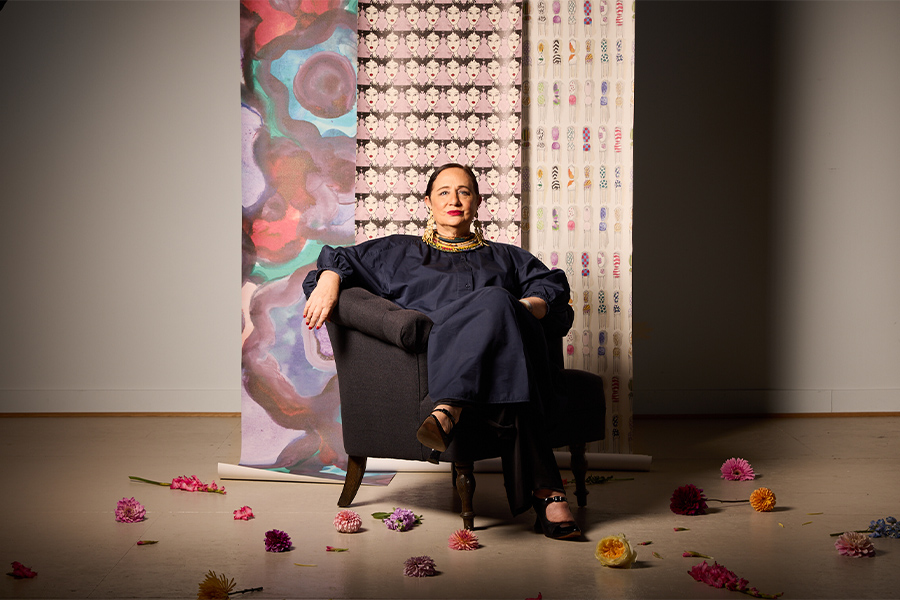Growing up in Cambria Heights, Queens with her 10 siblings, Pascale Sablan found a love for architecture at an early age. Her passion led her to pursue a bachelor’s degree in the field at the Pratt Institute in Brooklyn, New York followed by a master’s in advanced architectural design from Columbia University. As an activist architect, she is especially sensitive to how her work impacts the community. Additionally, Sablan continues to advocate for change as the National Organization of Minority Architects (NOMA) global president, where her mission is to eradicate racism, sexism, and all forms of oppression from the built environment.
When did you know you wanted to become an architect?
Pascale Sablan: When I was about 11 or 12 years old, I was [asked] to do a mural at the Pomonok Community Center in Queens [by my camp counselor because I was always playing with art supplies], and I decided to do a jungle gym with a multicultural community. While I was drawing my structure, somebody walked by and said, ‘You can draw straight lines without a ruler. That’s a great skill for an architect to have.’ It was the first time that profession was offered to me as an idea, and it felt like a perfect fit.
What did you learn from your first design-related job?
PS: When I was a third year, my first internship was at AARIS Design Architects in Manhattan. One of the first projects I participated on was going to the different [New York City] boroughs and presenting our design ideas. There were four other designers there, and the community had to vote on which one was their favorite. I saw the power of community and the power of language.

A rendering of the wood-clad Cleveland Foundation in Ohio, an S9 Architecture project with porous storefronts that are open to the community
Memorable career stops along the way?
PS: At S9 Architecture, I worked on Bronx Point [in New York], which is an affordable housing structure [with 542 units] and the first brick-and-mortar Universal Hip Hop Museum at the podium. I’m proud to have made that impact in the world and carry the vision of Navid Maqami [the late founder of S9 Architecture] and the design team as we worked through this project, which is currently in construction.
First work-related reality check?
PS: I presented to a city agency and our performance made it back to the client who said to my boss, ‘We no longer want you to present this project. We want it to be Pascale. She’s Black, she’s a woman, and she’s articulate.’ It was the first time my identity was something people pulled apart from my capabilities as an architect. [I am] mindful of how I navigate through that so I’m not tokenized in any way, but I also understand what that representation means to the communities I’m impacting through my work.
You’re currently the global president of NOMA. How has that informed your career?
PS: I joined NYCOBA|NOMA, which is the New York Coalition of Black Architects and the New York chapter of NOMA, in 2009. There, I had access to a network of diverse professionals who were fighting to make the profession more equitable. That’s when I found my community. It’s been an important journey to dovetail that whatever successes I have professionally, they are in step with all the great work and great people I have met being part of NOMA.

The inviting interiors of the Cleveland Foundation, where books hang from the ceiling
Tell us about your role at Adjaye Associates.
PS: We get to work on an incredible projects that focus on minority communities, culture, and identity. That has become a dream job for me in terms of the work I get to do, the people I work with, and the communities we get to impact.
Most challenging project?
PS: The Cleveland Foundation headquarters in Ohio [by S9 Architecture]. The client is an advocacy organization, and they were seeking an activist architect to lead the charge. It was one of the first times I was able to leverage my identity as an activist architect in the profession and see that it has a significant value on a project and client. Through developing that project, we entered into COVID and had to adjust how we collaborated with consultants, the client, and the stakeholders. It was opened earlier this year to an astounding round of applause from the community who are excited to see their ideas and thoughts manifest into the built environment.
What can’t you live without?
PS: My 7-year-old son, Xavier. He is the light of my life. He gives me purpose, and he gives me joy. Nothing matters without him, honestly.

Bronx Point in New York by S9 Architecture comprises affordable housing units and the Universal Hip Hop Museum


